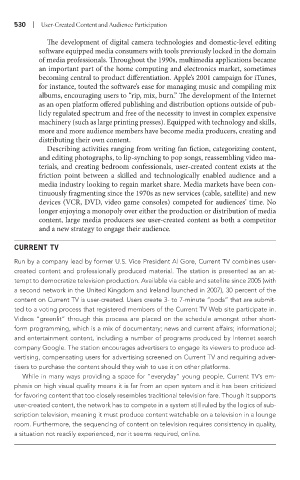Page 551 - Battleground The Media Volume 1 and 2
P. 551
0 | User-Created Content and Aud ence Part c pat on
The development of digital camera technologies and domestic-level editing
software equipped media consumers with tools previously locked in the domain
of media professionals. Throughout the 1990s, multimedia applications became
an important part of the home computing and electronics market, sometimes
becoming central to product differentiation. Apple’s 2001 campaign for iTunes,
for instance, touted the software’s ease for managing music and compiling mix
albums, encouraging users to “rip, mix, burn.” The development of the Internet
as an open platform offered publishing and distribution options outside of pub-
licly regulated spectrum and free of the necessity to invest in complex expensive
machinery (such as large printing presses). Equipped with technology and skills,
more and more audience members have become media producers, creating and
distributing their own content.
Describing activities ranging from writing fan fiction, categorizing content,
and editing photographs, to lip-synching to pop songs, reassembling video ma-
terials, and creating bedroom confessionals, user-created content exists at the
friction point between a skilled and technologically enabled audience and a
media industry looking to regain market share. Media markets have been con-
tinuously fragmenting since the 1970s as new services (cable, satellite) and new
devices (VCR, DVD, video game consoles) competed for audiences’ time. No
longer enjoying a monopoly over either the production or distribution of media
content, large media producers see user-created content as both a competitor
and a new strategy to engage their audience.
Current tV
Run by a company lead by former U.S. Vice President Al Gore, Current TV combines user-
created content and professionally produced material. The station is presented as an at-
tempt to democratize television production. Available via cable and satellite since 2005 (with
a second network in the United Kingdom and Ireland launched in 2007), 30 percent of the
content on Current TV is user-created. Users create 3- to 7-minute “pods” that are submit-
ted to a voting process that registered members of the Current TV Web site participate in.
Videos “greenlit” through this process are placed on the schedule amongst other short-
form programming, which is a mix of documentary; news and current affairs; informational;
and entertainment content, including a number of programs produced by Internet search
company Google. The station encourages advertisers to engage its viewers to produce ad-
vertising, compensating users for advertising screened on Current TV and requiring adver-
tisers to purchase the content should they wish to use it on other platforms.
While in many ways providing a space for “everyday” young people, Current TV’s em-
phasis on high visual quality means it is far from an open system and it has been criticized
for favoring content that too closely resembles traditional television fare. Though it supports
user-created content, the network has to compete in a system still ruled by the logics of sub-
scription television, meaning it must produce content watchable on a television in a lounge
room. Furthermore, the sequencing of content on television requires consistency in quality,
a situation not readily experienced, nor it seems required, online.

